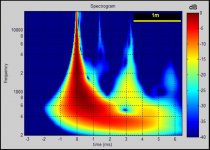A couple of decades later I experienced the multi-cell in a Hi-Fi setting and was amazed. With better than stock EQ and crossovers I've never heard speaker sound as natural, as true to life. I have heard more detail, but not more natural. Acoustic or studio, mono or stereo, all amazing. That got me hooked.
Now in the 21st century I simply get good results from the multi-cell whether it's in a listening room or on the side of a mountain. Wood or metal, tar filled or not. The coverage is clean, clear and even. The image is strong and stable. They work so well for me that I really don't need to pursue anything else. I hope that helps clarify my point of view.
This clarifies a lot.
Throughout (t)his thread camplo has set out his objectives clearly and precisely.
Like camplo, we all have our own personal set of objectives and preferences, even though these are not always as well defined.
camplo's quest, may not be everybody's cup of tea, but it's an interesting endeavor nontheless.
In this thread about the construction of a multicell horn, the builder made an interesting comment:
"A Kugelwellen multicellular horn would be kind of cool to try build due to better coupeling to the free air at the horn mouth."
If anything, you'd want to have a horn that shows one of the cleanest pulse results, or viewed in that paper as wavelets. At least I would want that if I were after a reference quality horn for studio work.
In my book that would point to a smooth driver - throat transition and a generous round-over at the mouth to get it. But there's always compromises to make, and I just wonder how far camplo is willing to go size wise to check all these boxes... At least i would think a generous roundover would make his round horn bigger than he'd like it to be?
A square, ellipse or rectangle horn would still have that energy after the pulse, but more smeared out (due to those different path lengths). So it could be one has to choose (as always) your set of compromises to get close to what you'd want.
We are not after the best horn in just any room here, we moved past CD type as requirement because the room/speaker setup would be adjusted for best performance, looking for a more nearfield use than regular entertainment setups would use.
But can we create that 200-20K (or as close as possible) horn within the size constraints camplo is willing to make, keeping in mind the best possible (non CD) performance. My bet is the horn when done without compromise (for this specific task) could turn out to be larger than camplo would want it to be.
This is a nice follow-up to Pano's post.
In order to reproduce signals as true to source/reference quality as possible, it seems wise to opt for a horn that takes the Axi2050's potential to the max.
The question remains: "Can camplo make it work?"
I think it's SAFE to say: Yes, he... (click!)
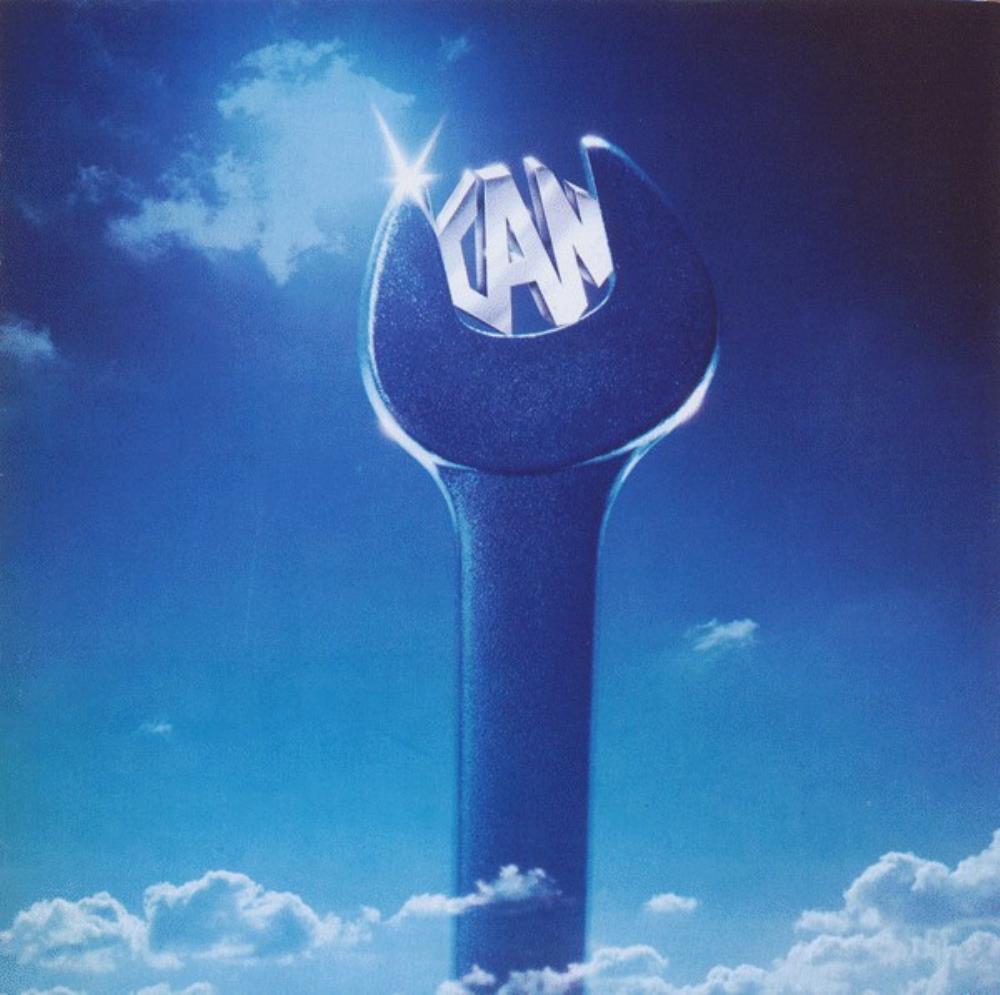
Last edited:
Oh my...that was 10 years ago... Today, I would have 3D printed it. The horns are sold but I still remember their effortless sound. Above 4 kHz, the 2445 or mouth fingering started to have negative influence on the sound quality.
Hi Petter, thanks for joining in.
Like many members of this forum I was impressed with your craftsmanship.
Those multicells were truly stunning.
Are you still using (DIY) horns today?
Like many members of this forum I was impressed with your craftsmanship.
Those multicells were truly stunning.
Are you still using (DIY) horns today?
drba_swh_160_sq_pe_rb - BEM sim
This is an ABEC sim of the horn from post #4288 Is it possible to cover the whole spectrum, high spl, low distortion with a 2-way?
I understand from @docali that this does not have constant flare rate. Its has progressive T factor to force shorter axial length so its a compromise.
The simulation model is for 4Pi space and accurate to about 6Khz. The mesh resolution was reduced so this model could run in a reasonable time.
This is an ABEC sim of the horn from post #4288 Is it possible to cover the whole spectrum, high spl, low distortion with a 2-way?
I understand from @docali that this does not have constant flare rate. Its has progressive T factor to force shorter axial length so its a compromise.
The simulation model is for 4Pi space and accurate to about 6Khz. The mesh resolution was reduced so this model could run in a reasonable time.
Attachments
-
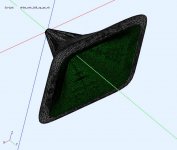 drba_swh_160_sq_pe_rb-3Dview.jpg54.8 KB · Views: 348
drba_swh_160_sq_pe_rb-3Dview.jpg54.8 KB · Views: 348 -
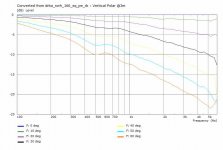 drba_swh_160_sq_pe_rb-VpolarCurves@3m.jpg37.7 KB · Views: 102
drba_swh_160_sq_pe_rb-VpolarCurves@3m.jpg37.7 KB · Views: 102 -
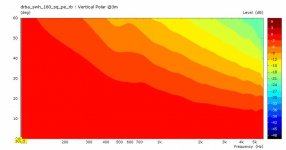 drba_swh_160_sq_pe_rb-Vpolar@3m.jpg22.4 KB · Views: 101
drba_swh_160_sq_pe_rb-Vpolar@3m.jpg22.4 KB · Views: 101 -
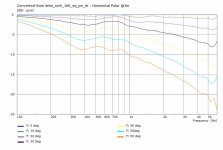 drba_swh_160_sq_pe_rb-HpolarCurves@3m.jpg37.9 KB · Views: 104
drba_swh_160_sq_pe_rb-HpolarCurves@3m.jpg37.9 KB · Views: 104 -
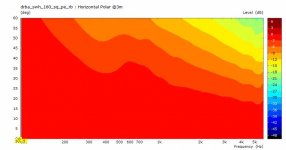 drba_swh_160_sq_pe_rb-Hpolar@3m.jpg22.5 KB · Views: 349
drba_swh_160_sq_pe_rb-Hpolar@3m.jpg22.5 KB · Views: 349 -
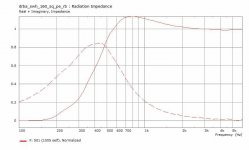 drba_swh_160_sq_pe_rb-RadImp.jpg33.2 KB · Views: 344
drba_swh_160_sq_pe_rb-RadImp.jpg33.2 KB · Views: 344 -
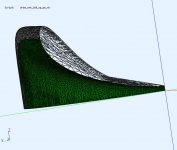 drba_swh_160_sq_pe_rb-Xsection.jpg52.4 KB · Views: 355
drba_swh_160_sq_pe_rb-Xsection.jpg52.4 KB · Views: 355
.. and some observation fields
Attachments
-
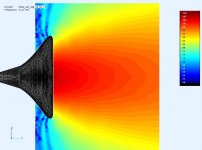 Vfield_5.2KHz.jpg50.5 KB · Views: 90
Vfield_5.2KHz.jpg50.5 KB · Views: 90 -
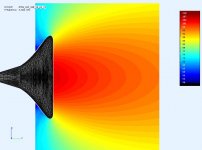 Vfield_3KHz.jpg47.6 KB · Views: 87
Vfield_3KHz.jpg47.6 KB · Views: 87 -
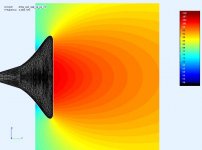 Vfield_1KHz.jpg45.6 KB · Views: 84
Vfield_1KHz.jpg45.6 KB · Views: 84 -
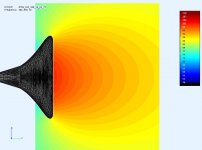 Vfield_400Hz.jpg43.8 KB · Views: 90
Vfield_400Hz.jpg43.8 KB · Views: 90 -
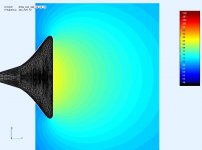 Vfield_160Hz.jpg45 KB · Views: 94
Vfield_160Hz.jpg45 KB · Views: 94 -
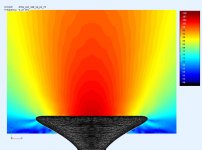 Hfield_5.2KHz.jpg53 KB · Views: 83
Hfield_5.2KHz.jpg53 KB · Views: 83 -
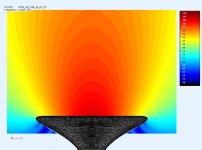 Hfield_3KHz.jpg50.9 KB · Views: 88
Hfield_3KHz.jpg50.9 KB · Views: 88 -
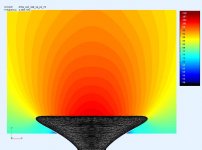 Hfield_1KHz.jpg48.1 KB · Views: 86
Hfield_1KHz.jpg48.1 KB · Views: 86 -
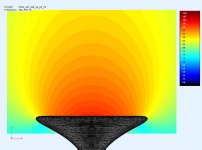 Hfield_400Hz.jpg46.6 KB · Views: 99
Hfield_400Hz.jpg46.6 KB · Views: 99 -
 Hfield_160Hz.jpg48 KB · Views: 102
Hfield_160Hz.jpg48 KB · Views: 102
Yes, there are a few more horns coming, including the Jericho.
Yes you could learn to build the model and simulate in ABEC. A simple matter of time and effort 🙂
Yes you could learn to build the model and simulate in ABEC. A simple matter of time and effort 🙂
Thanks, Don!
This horn performs better than I expected. The maximum T factor was about 3 here. So, a very drastic reduction of the length.
But it may not fulfill camplos requirement for low signal loading.
This horn performs better than I expected. The maximum T factor was about 3 here. So, a very drastic reduction of the length.
But it may not fulfill camplos requirement for low signal loading.
I wish I could spend some cash to buy these: HIFI4ALL.DK | Køb Salg Bytte | Bms horn (for English, please use Google translate, it works good enough for me). Although with a bass unit, it would be three way.
OK so, regarding the horn above, it is based off of a 160hz model but with the progressive T it is expected to not load as low as the original of this file. Equally important, the original 160hz horn model dimensions aren't known (to the spectators of this) so, as well, we cannot know whether the horn is following the practice of using axial throat length to translate Fc at 1/2WL.
Compromise will have to take place! This whole thread is based off pushing an objective and exposing where the compromise will be. With the purchase of the AXi I have compromised my pocket book lol!
When looking into the points that you have brought up, first I looked at the horns (Musique Concrète J321 Le Cleac'h horn) suggest Fc, the area where the decay is cutting sharply above 3ms, and the only decay measurements I could find of the AETD15M. So the AE has much tighter decay than this horns lower response...at 200-300hz we are verging on the nominal schroeder frequency, which is somehow relevant, and contending with the single point source concept. I think that crossing within the transition of the schroeder frequency generalized to say 200-300hz for the average room?...is a good idea. In the idea of being a signal purist a higher decay from a driver is never acceptable right? but if you had to compromise on that would you not want to have that happen where the rest of spectrum in that area is likely to agree? So potentially this would cause me to perceive a form of exaggeration in that area....I'll eat that, I dislike 250-290hz lol!!!
A pattern I think I see is for this tightening of decay to be ~156% above the fc of sperical and the jmlc horn in that review. That would put me at 128hz if I ran with that theory for a 200hz horn. Before the decay increases dramatically, appears to be at 420ish..which ~131% of 321hz which would be 153hz for 200... if that math is even logical, then 160hz is not a crazy place to land, given that the trend holds true for round horns of similar shape. I would like to believe that the schroeder frequency is going to help hide some of the blemishes. Also I think there is a connection between the tightening of decay and the point where a horn begins to be strongly directive based on is diameter so if that were true a larger horn has benefits there, as well if its not true, there are still the benefits of having directivity in general, at a lower frequency than a smaller horn use for a higher crossover.
So in short, I think 160hz is already the compromise I am looking for, if the width is what I think it is...somewhere near 30"?
The larger mouth radius also increases the sheer size of the horn. I remember posting the paper on this very thread that sports measurements on several different types of horns (16 in total) and the late energy they show in those measurements, arriving after the first pulse: http://unepassionaudiophile.fr/wp-content/uploads/2018/01/Horns_measurements_ETF2010d-1.pdf
... My bet is the horn when done without compromise (for this specific task) could turn out to be larger than camplo would want it to be.
Compromise will have to take place! This whole thread is based off pushing an objective and exposing where the compromise will be. With the purchase of the AXi I have compromised my pocket book lol!
When looking into the points that you have brought up, first I looked at the horns (Musique Concrète J321 Le Cleac'h horn) suggest Fc, the area where the decay is cutting sharply above 3ms, and the only decay measurements I could find of the AETD15M. So the AE has much tighter decay than this horns lower response...at 200-300hz we are verging on the nominal schroeder frequency, which is somehow relevant, and contending with the single point source concept. I think that crossing within the transition of the schroeder frequency generalized to say 200-300hz for the average room?...is a good idea. In the idea of being a signal purist a higher decay from a driver is never acceptable right? but if you had to compromise on that would you not want to have that happen where the rest of spectrum in that area is likely to agree? So potentially this would cause me to perceive a form of exaggeration in that area....I'll eat that, I dislike 250-290hz lol!!!
A pattern I think I see is for this tightening of decay to be ~156% above the fc of sperical and the jmlc horn in that review. That would put me at 128hz if I ran with that theory for a 200hz horn. Before the decay increases dramatically, appears to be at 420ish..which ~131% of 321hz which would be 153hz for 200... if that math is even logical, then 160hz is not a crazy place to land, given that the trend holds true for round horns of similar shape. I would like to believe that the schroeder frequency is going to help hide some of the blemishes. Also I think there is a connection between the tightening of decay and the point where a horn begins to be strongly directive based on is diameter so if that were true a larger horn has benefits there, as well if its not true, there are still the benefits of having directivity in general, at a lower frequency than a smaller horn use for a higher crossover.
So in short, I think 160hz is already the compromise I am looking for, if the width is what I think it is...somewhere near 30"?
Attachments
Last edited:
there are still the benefits of having directivity in general, at a lower frequency than a smaller horn use for a higher crossover.
So in short, I think 160hz is already the compromise I am looking for, if the width is what I think it is...somewhere near 30"?
I agree. Have you built the horn yet and taken measurements? I've done a 600Hz biradial that you may be interested in...
Joseph Crowe's DIY Speaker Building Blog: ES-600 Biradial Horn
Next week a 290Hz version goes on the CNC made from bamboo plywood. Still not 160 Hz.
I think that I have found the right horn for camplo and his size restrictions. If I remember well the exponential horn has a terminated mouth and it is terminated at 45 deg. For this angle the reflecting waves from mouth to throat from it's real and imaginary part should theoretically cancel. Therefore, this is a horn of this type derives from spherical wave horn with T=0.7. the length s about 90cm:
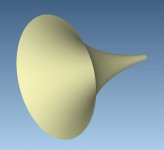
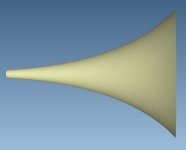
View attachment drba_swh_147_T07_Jericho.zip


View attachment drba_swh_147_T07_Jericho.zip
I think that I have found the right horn for camplo and his size restrictions. If I remember well the exponential horn has a terminated mouth and it is terminated at 45 deg. For this angle the reflecting waves from mouth to throat from it's real and imaginary part should theoretically cancel. Therefore, this is a horn of this type derives from spherical wave horn with T=0.7. the length s about 90cm:
View attachment 795090 View attachment 795091
View attachment 795092
Now you are just showing off 😀😀😀
and here a second version which has a slightly larger mouth diameter because of expanding T and lower base cut-off. Btw, the cut-off has not the same meaning as for the typical swh. The construction vector is determined by the cut-off value.
View attachment drba_swh_120_T07-T20_Jericho2.zip
View attachment drba_swh_120_T07-T20_Jericho2.zip
Now you are just showing off 😀😀😀
But do not complain if someone would later say " beam me up camplo" 😀
I was just thinking, These in one setting are a one mans show, or tools for sound engineering, or at least a custom tool for me. Nothing stops me from changing my set-up at any given time. I mean the horns are not permanently attached to the driver.....When I wanted to approach things from the other side of the spectrum, going completely wide dispersion, couldn't I just run the drivers without a horn and raise the crossover? Someone once made the comment that the best tweeter they heard outside of a horn was a compression driver without a horn. So I have no idea how that works but if that was a not the way then sure'y I would have another horn/waveguide to switch to for entertainment time with the family, which by my guess would be some type of (CD) waveguide or biradial, geared towards a 630hz crossover.
Last edited:
I was just thinking, These in one setting are a one mans show, or tools for sound engineering, or at least a custom tool for me. Nothing stops me from changing my set-up at any given time. I mean the horns are not permanently attached to the driver.....When I wanted to approach things from the other side of the spectrum, going completely wide dispersion, couldn't I just run the drivers without a horn and raise the crossover? Someone once made the comment that the best tweeter they heard outside of a horn was a compression driver without a horn. So I have no idea how that works but if that was a not the way then sure'y I would have another horn/waveguide to switch to for entertainment time with the family, which by my guess would be some type of (CD) waveguide or biradial, geared towards a 630hz crossover.
I have a hard time believing that to be the case. Maybe this person hasn't heard a good horn. A good horn will not introduce any more resonance than other resonances in the system. Here is a TAD TD-2001 on a 'good' horn. There's no resonance to speak of except for some room reflections starting to be introduced at 2kHz.
https://1.bp.blogspot.com/-QSZ6YcSh...cSHew8Cso7w9QCLcBGAsYHQ/s1600/Burst+Decay.JPG
I have a hard time believing that to be the case. Maybe this person hasn't heard a good horn. A good horn will not introduce any more resonance than other resonances in the system. Here is a TAD TD-2001 on a 'good' horn. There's no resonance to speak of except for some room reflections starting to be introduced at 2kHz.
https://1.bp.blogspot.com/-QSZ6YcSh...cSHew8Cso7w9QCLcBGAsYHQ/s1600/Burst+Decay.JPG
- maybe I didn't say it right. All they meant was, of all the drivers they heard that were not in horn (dome, ribbon, etc), a compression driver without its horn sounded awesome to them. They were in favor of tweeters in a horn but the discussion was about non horned drivers.Someone once made the comment that the best tweeter they heard outside of a horn was a compression driver without a horn
Last edited:
- maybe I didn't say it right. All they meant was, of all the drivers they heard that were not in horn (dome, ribbon, etc), a compression driver without its horn sounded awesome to them.
oops, yes it's obvious now that I read it correctly! It would be easy to try. I suspect the phase plug could be removed in this case and vented into a damped chamber. Some of the diaphragms look cool too.
- Home
- Loudspeakers
- Multi-Way
- Is it possible to cover the whole spectrum, high SPL, low distortion with a 2-way?

